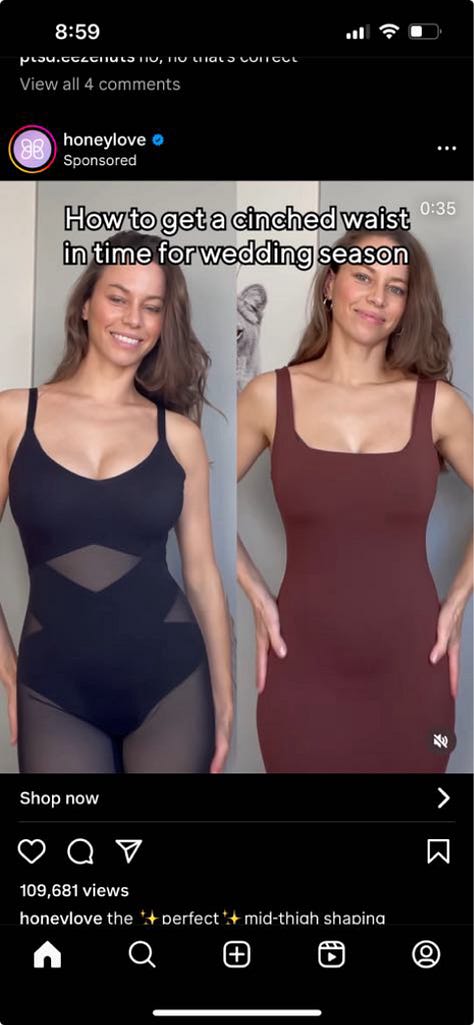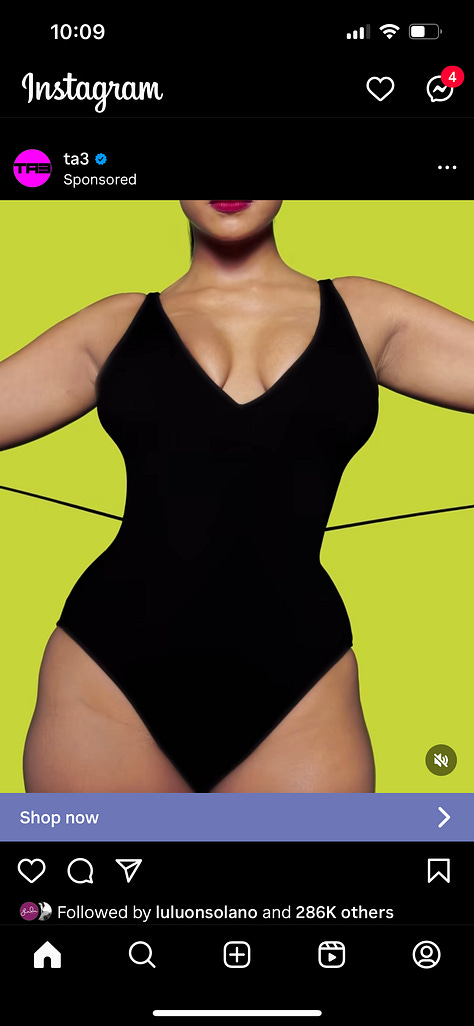I tell my friend that lately all the ads on my Instagram feed are shapewear promising hourglass figures, or shapewear masquerading as swimsuits, or shapewear built into dresses and tops. That or the startup that offers fertility testing with a pinprick of blood or sperm-friendly lube or a woman who says Did you know all these foods compromise your fertility before pulling out an entire produce section and a loaf of bread. The algorithm wants me skinny or knocked up, I say.
Wow, says my friend, who just had a threesome. There’s something really primal about that.
(The evolutionary biologists might agree. Isn’t the story that men want women with hourglass figures because it signals reproductive capability, that women desire different types of men — with different face shapes or smells — depending on where they are in the menstrual cycle and, it’s implied, pregnability, that our reproductive decisions race inexorably towards some kind of frenetic drive to make copies of ourselves as best we can?)
(The evolutionary biologists could afford to be more reflexive about how their socialization changes their science. Elizabeth Lloyd tells us that scientists convinced of the importance of monogamy chose to draw conclusions about humans by studying chimpanzees — but they could just as well have studied the more casually promiscuous bonobos. In Undoing Monogamy Angela Willey writes a whole chapter about how scientists studying the “monogamy gene” in prairie voles reify a tautology in which monogamy is considered natural because of genetics findings from voles and the voles are considered an ideal model organism to do translational research — wherein vole characteristics are stand-ins for human ones — because of their monogamy.)



Is it primal to want to have and/or fuck someone with a snatched waist — this is the parlance of multiple ads, that word snatched? Does it matter? Cue Billie Eilish’s elegiac “What Was I Made For?” as I go round and round on the glowing carousel of Instagram, assailed by multiple ads that all go like this: a normal-looking woman expresses her skepticism about the Product (viral bodysuit, Skims lounge dress), she yanks the Product onto her body, and voila! No muffin top in the skirt that used to be too tight. Boobs look great. What did you do, Kimberly?! They always look surprised. Bitch, you know what will happen when you force the bits and bobs of your animal body into a tiny thermoplastic suit. That feeling is the fossils that got ground into petroleum and extruded into nylon threads sinking their teeth in, holding on tight.
I shouldn’t be so ungenerous. I was a shocked woman once. I was looking for something to wear under a sheer dress. My friend offered her Skims bodysuit, so I stood in her Crown Heights apartment looking at myself in her bodysuit, in her mirror, wondering where my stomach had gone. When you wear shapewear you learn how much capacity your body has to be pushed in onto itself, how much discomfort and outright pain you can withstand, how much you can breathe without any air actually making it to your diaphragm. No one will congratulate you for this valor, no one will give you a medal for the wound.
We might not have shapewear as it exists today without wartime. (Or activewear.) Polyester, nylon, and elastane are some of the synthetic fabrics that make up a Skims bodysuit. Nylon was used for WWII parachutes. Nazi Germany developed polyurethane and used it for coatings on fighter jets; now that’s your elastane, Spandex, and Lycra. Like other synthetics, polyester was developed majorly by the DuPont Corporation during WWII and the postwar economic boom. As they go round and round in a washing machine, these clothes leach microplastics into our collective water supply. Our man-made textiles will outlive us, scattered in the stomachs of fish.
I didn’t borrow my friend’s bodysuit. But I looked it up online. Ever since then — or was it before? — the shapewear ads have kept coming. I hit “Hide Ad” -> “It’s irrelevant” because I don’t think it’s good for my psyche to see dozens of women reveling in reducing themselves but maybe it’s also my fault, isn’t the algorithm giving me exactly what I want? I sent this Reformation dress to a friend with the comment “have so many conflicted thoughts and feelings about this dress...it's giving american revolution porno.” I want it, of course.
The other day, not on Instagram, I saw more “extreme corseting” — that’s what the New York Times called Kim Kardashian’s Met Gala outfit (Maison Margiela by John Galliano). Kardashian’s outfit was a continuation of a stylistic technique on display in Margiela’s 2024 show, where Galliano’s mood boards “displayed the bruises left on the models’ flesh by the lacing.” There’s something that feels mystical and quasi-religious here about the mortification of the flesh, the discipline and denial and flagellation.
But a designer putting an injurious corset onto workers who have little recourse against his whims, at least not if they want to get employed in the future, at least not if they don’t want to get a reputation as divas who don’t follow instructions and wear what they’re given — a designer doing this seems like just a grimy abuse of labor. Maybe all the possible interpretive frames for snatching I’ve offered, sex and war and worship, pale in comparison to the simple possibility that this is work. You might take pleasure in the prospect of appearing a certain way, but that doesn’t negate the fact that it requires embodied effort and pays certain dividends — more, I’d wager, to Kim K than to your average PhD student. Scholars have written about the concepts of beauty work and aesthetic labor, particularly the ways appearance expectations are gendered and more severe for women than for men.
If the ads hail me as a worker (though a chimerical type: someone enticed to both labor and consume), I feel (slightly) more agentive. It’s not that some immutable essence or nature leads me to want to have a particular kind of body, only that other people look this way and buy this shit and Instagram knows it can profit from me beginning to wonder Should I have a snatched waist, too? As a worker, though, you have more options. Coordinating with others on collective action, working slowly and poorly to achieve a slowdown or stoppage, and walking away entirely. (Or buying into the logic of the firm, rising to middle management, and delivering orders to others.) We’re not meant to think of ourselves as workers when we’re at home on the couch scrolling through an app in our free time, but aren’t we handing over our attention and our data and opening ourselves up to algorithmic direction? I open the app and Instagram sells me to the highest bidder: not just my eyeballs and my search history, but the possibility of my desire. I’d be lying if I said I didn’t like the feeling. I don’t know if “like” is the right word. The women in the ads make their surprised faces, knot and cinch and bind, dare me to scab. Isn’t it obvious why I keep getting these ads? There’s always a second I can’t look away.
this week I consumed: Macklemore’s 💯 rap “Hind’s Hall,” which vindicates 16-year-old me for quoting him in my college applications; law students for Palestine documenting protest on campuses in this LPE blog post “From the Encampments”; and Martín Kohan’s short novel Confession about lust, guilt, and military rule in Argentina
Header image: Fat Lady by Sun Hongbin (孙红宾), 2013. White Rabbit collection. (My sister gave me a birthday card with this image on it because she said it reminded her of me.)




